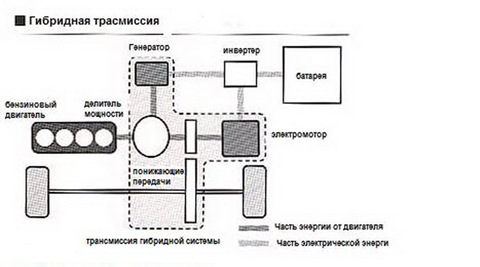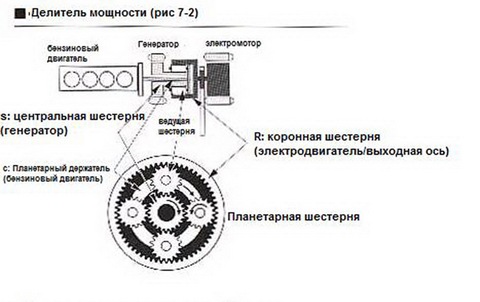hybrid transmission - Toyota Estima, 2.4 L, 2001

Automotive powertrains that use a combination of the two are called hybrid systems. In a hybrid system, each energy source is designed to maximize its benefits while offsetting each other's disadvantages.
For example, the electricity generated by the engine drives an electric motor, and the system can select the power of the car, both from the engine and from the electric motor, based on the speed and driving conditions.
There are two types of hybrid systems:
1) Sequential Hybrid System
In this type, the engine drives a generator, which generates electricity, which powers an electric motor that drives the wheels. This is called a serial hybrid because power flows in a straight line. The sequential hybrid system operates the small engine at its most efficient speed, resulting in excellent fuel economy and reduced harmful emissions.
2) Parallel hybrid system:
In this type, both a motor and an electric motor drive the wheels. Because power flows along two parts, this system is called parallel. system. This system also allows the engine to recharge the battery while supplying power to the vehicle.
THS (Toyota Hybrid System) targets
The goals of THS are to achieve double the fuel economy of vehicles powered by conventional internal combustion engines, significantly reduce exhaust emissions, and guarantee smooth, powerful performance.
1. System Diagram:
THS offers the advantages of both parallel and serial systems.
The car is driven by both an engine and an electric motor, with the engine providing primary power. The system divides the power of the motors with a power divider using a planetary gear train to distribute power between the drive shaft and the generator. Some of the electricity from the generator drives the electric motor. The remainder, after being converted to DC by the inverter, is accumulated in the batteries.
The THS transmission, consisting of power divider, electric motor, generator and crawler gears, is compact enough for a passenger car.
Engine: high efficiency 1.5 liter gasoline engine.
THS transmission: power divider: distributes power through a planetary gear system.
Electric motor and generator: permanent magnetic synchronization type.
Battery: Nickel hydride.
2. High Achievements in Fuel Economy
(1) High Efficiency Engine
The primary energy source is a newly developed 1.5 liter high expansion ratio engine based on the Atkinson cycle for remarkable low pumping and friction losses.
(2) Improved engine range
The engine achieves its best fuel consumption per unit of production by operating in high torque ranges. Therefore, depending on the state, the system monitors the power sharing between the engine and the electric motor so that the engine always operates in the maximum torque range. The engine also automatically runs within a constant rev range, thereby maximizing fuel efficiency.
(3) Engine cut-off system:
When the vehicle is stopped or moving at low speed, the engine will automatically shut off to save fuel and reduce emissions.
(4) Regeneration and reuse of braking energy:
When the vehicle slows down, the engine acts as a generator, converting kinetic energy into electrical energy and sending it through an inverter to be stored in batteries.
3. Achieve Smooth Acceleration and Deceleration:
Since the THS transmission functions as an electrically controlled variator and an electric motor assists the engine, vehicles with THS achieve smooth acceleration and deceleration, smooth superior response.
In particular, the initial acceleration benefits the performance of the motor - high torque at low speed. For maximum acceleration when the throttle is open, the power of both the engine and the electric motor drives the vehicle, with energy from the battery, increasing the engine's output.
(System Operating Modes)
Startup / Easy Boot
When starting, driving at low speeds, descending a slight incline, or operating in other conditions in which the engine is not at its peak, it turns off and the electric motor drives the vehicle (A).
Normal driving
The power divider distributes the engine power in two ways. One part drives the wheels (B) The
other drives a generator that generates electricity for the electric motor, which provides additional driving force to the wheels (C)
The system monitors the power ratio along each path for maximum efficiency.
Wide Open Throttle Acceleration
During this acceleration, the battery also supplies power, increasing the engine power output (A).
Deceleration / deceleration
During deceleration and braking, the inertia of the wheels turns the electric motor, which then acts as a generator. The recovered electricity is stored in the battery (A).
Battery recharge: The
battery is adjusted to maintain a constant charge. When the battery is discharged, the battery directs power to charge it (D)
Stopping
The engine automatically shuts off when the vehicle is stopped.
PS This is an excerpt from the Toyota Press Fact Sheet. Unfortunately, I cannot insert pictures.

And how long does the battery last under the condition of constant discharge-charge cycles?
According to the sources, this battery lasts longer, the more often the charge-discharge occurs. I read recently that in Australia PRIUS traveled about 500,000 km in a taxi without changing the battery. In any case, my "battery" is already 7 years old and is normal.
What type of battery? In theory, the more discharge-charge cycles a battery experiences, the faster the active substance is destroyed and the shorter the service life.
The THS battery marks further advancements in sealed nickel hydride technology that has been specifically designed for EVs. It offers improved power output (triple the power of EV batteries), sealing and durability, and reduced weight. These high-tech batteries are an excellent match for Toyota's Hybrid System.
These batteries are specially developed by Panasonic by Toyota and have 5,000,000 charge-discharge cycles with a 20% loss in capacity. Developed according to "closed" technologies, the same ones are used in Japanese military equipment. If we count on a calculator 200 charge-discharge cycles per day, we get 25.5 years of comfortable everyday operation if used correctly. Since the batteries are controlled by a computer, their incorrect operation is excluded (if you do not climb there with crooked hands and do not drive without gasoline, and also turn on the car to charge the batteries at least once a month). There is no way to raise other details of the technical documentation for these elements, but my practice has shown that in no case should these elements be discharged below 1.05 volts - their self-discharge grows so much, that they boil and flow. Elements that have not been used for a long time, but have not yet "sagged" to the critical voltage, lose some of their capacity, but it is restored again after 5-7 full charge-discharge cycles (1.15v-1.35v) with a large current.